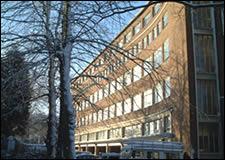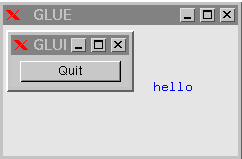10. GLUE
 Note: C++ doesn't have graphics. The graphics routines that we've added
might not be used elsewhere. You won't be examined on them.
Note: C++ doesn't have graphics. The graphics routines that we've added
might not be used elsewhere. You won't be examined on them.
GLUE is a Graphics Library for Undergraduate Education which is designed for use by students learning C++.
When you write a graphical program, you need to cope with the user resizing or uncovering the window at any moment. In practise it means that graphical programs will be structured differently to non-graphical ones, ready to react to the user's actions. With GLUE all you need to do is to define which function to run in these circumstances - GLUE will call it for you at the right time. GLUE offers you the chance to respond to key-presses and mouse-clicks too. Here's a simple example - the code and the resulting executed program.
// Compile using
// g++ -I/usr/local/include -I/usr/include/GL -L/usr/local/lib
// ... -lglue -lglui -lglut -lGLU -lGL
#include "glue.h"
void mygraphics(int w, int h) {
color(BLUE);
text("hello", 150,h/2);
}
int main() {
glueWindow();
graphicsfunction (mygraphics);
glueGo();
}

- glueWindow() creates a window of default size and color. The default background colour is WHITE and the default foreground colour is BLACK
- graphicsfunction defines which routine (in this case mygraphics) will be used to draw in the window. This routine will be called when the window first appears, when it's resized, and when it's unobscured or de-iconified. Note that the graphics routine is always given the window's current width and height. In this example the text is drawn half-way down the window.
- glueGo() starts the graphics. The window won't appear until this routine is called. The routine won't end until the graphics window is closed (whereupon it will make the program quit), so it's often the last command in the main routine. By default there's a floating "Quit" button that can be used to quit the program.
Coordinates
- The initial window is positioned using screen coordinates - (0,0) is bottom-left.
- For routines that draw into the window, all coordinate are in pixels by default, (0,0) being bottom-left of the window rather than the screen.
- Once some axes have been drawn, you can have the coordinates interpreted as relative to the axes. For example, if your x and y axes run from 0 to 1, drawing a line from (0,0) to (1,1) will draw a diagonal line to fill the axes area as long as you've chosen AXES as your coordinate system. PIXELS is the default.
A note about C++ parameter default values
In C++ you don't always need to supply all the parameters to a function. The routines below use this facility to help make your programs shorter. Any parameter mentioned below with a = sign after it can be left out as long as there are no more following parameters. The omitted parameters are given the stated default values. So glueWindow(500,500) is legal, setting the window's width and height to 500, but using the default values for the other parameters.
Routines
-
void glueWindow(int width=640,int height=480,int xpos=50,int ypos=50, int color=WHITE, bool quitbutton=true);
Create a window. The color can be one of BLACK, RED, GREEN, YELLOW, BLUE, MAGENTA, CYAN, WHITE. The final parameter specifies whether a Quit button appears. -
void glueGo();
Activates the graphics. This routine doesn't return until the graphics window is closed. -
void keyboardfunction(void (*func)( unsigned char, int x, int y));
Use the routine called func to process keyboard presses. The routine has to accept 3 arguments. The first gives the ASCII value of the key pressed, the other 2 give the mouse pointer coordinates. -
void mousefunction(void (*func)(int button, int state,
int x, int y));
Use the routine called func to process mouse button presses. The routine has to accept 4 arguments. The first contains the mouse button pressed (GLUE_LEFT_BUTTON, GLUE_MIDDLE_BUTTON, or GLUE_RIGHT_BUTTON), the 2nd holds information on whether the button was pressed or released (GLUE_UP or GLUE_DOWN), the last 2 give the mouse pointer coordinates. -
void graphicsfunction(void (* func)(int w, int h));
Use the routine called func to produce graphics. The 2 parameters given to the routine by GLUE provide the window's current width and height. -
void move(double x, double y, int coords=PIXELS);
Set the "current position" to (x,y) but don't draw anything. By default, the PIXEL coordinate system is used. The alternative is to use the AXES coordinate system. -
void draw(double x, double y, int coords=PIXELS);
Draw a line from the "current position" to (x,y), and set the "current position" to (x,y). By default, the PIXEL coordinate system is used. The alternative is to use the AXES coordinate system. -
void text(string txt, int x, int y, void* font=TIMES13) ;
Display the txt at position (x,y). Possible fonts are TIMES10, TIMES13, TIMES24, HELVETICA10, HELVETICA12, HELVETICA24 -
void color(int);
Set the color to one of BLACK, RED, GREEN, YELLOW, BLUE, MAGENTA, CYAN, WHITE. -
void color(float red,float green, float blue);
Set the color to an RGB value, the components being in the range 0 to 1. -
void filledrectangle(int x, int y, int w, int h);
Fill a rectangle with the current color -
void filledcircle(int x, int y, int r, int num_lines=100);
Fill a circle of radius r centred on (x,y) with the current color. The circle is drawn as a regular polygon with 100 sides by default. -
void xaxis(float xlo, float xhi, int nxticks, float y, float ticksize,
string title, float labello, float labelhi, int decplaces=2);
Draw an x-axis from (xlo,y) to (xhi,y). Put nxticks tickmarks along the axis, the marks being ticksize pixels long. ticksize can be negative, in which case they point up rather than down. Print labello near (xlo,y) and labelhi near (xhi,y). Use title as the X axis title. The final parameter shows how many decimal places are shown in the tickmark labels -
void yaxis(float ylo, float yhi, int nyticks, float x, float ticksize,
string title, float labello, float labelhi, int decplaces=2);
Draw a y-axis from (x,ylo) to (x,yhi). Put nyticks tickmarks along the axis, the marks being ticksize pixels long. ticksize can be negative, in which case they point right rather than left. Print labello near (x,ylo) and labelhi near (x,yhi). Use title as the Y axis title. The final parameter shows how many decimal places are shown in the tickmark labels - int coordsystem(int coords);
Set the coordinate system to use for future operations. Return the previous coordinate system. Options are PIXEL and AXES.
